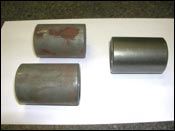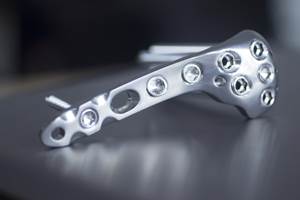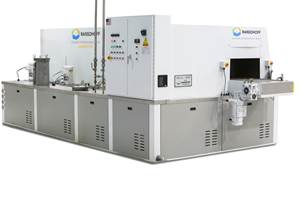Water-Based Rust Solution Boosts Productivity
Rust and corrosion can be problematic when working with cold rolled steel (CRS). Despite even the most heroic preventive measures, manufacturers report troublesome, rusty parts that can be attributed to seasonal humidity, being located near bodies of salt water, long-term indoor storage, unprotected shipping methods, condensation and coolant residues.
Share







Takumi USA
Featured Content
View More
ECi Software Solutions, Inc.
Featured Content
View More.png;maxWidth=45)
DMG MORI - Cincinnati
Featured Content
View MoreRust and corrosion can be problematic when working with cold rolled steel (CRS). Despite even the most heroic preventive measures, manufacturers report troublesome, rusty parts that can be attributed to seasonal humidity, being located near bodies of salt water, long-term indoor storage, unprotected shipping methods, condensation and coolant residues.
When rust occurs, harsh chemical treatments such as acids or high-pH solutions are often recommended to remove the unsightly, reddish-brown coating. Typical concerns associated with these options—safety issues and the expense of waste treatment—can cause companies to shy away from using a caustic form of removal. One commonly-employed alternative is plain old elbow grease. Though effective, this method is labor-intensive, and it is therefore not viable as a cost-effective measure for many businesses.
Despite taking every precaution, Fairlawn Tool & Die Co., Inc. observed part rust at its facility. It attributed the rust to factors such as long part storage times, seasonally high humidity and salt-laden air from Chesapeake Bay. To combat its rust issues, the Hampstead, Maryland-based shop formerly used hand scrubbing with an abrasive and solvent-oil corrosion inhibitor. The process did work rather well, but it was expensive because of labor, the lengthy time required to clean small parts, incomplete removal in recessed shapes such as threads, and the latent film that covers parts, which would smoke during welding.
Eventually, the company migrated away from this manual method, instead opting for a water-based solution—Picoclean X-Rust—by Pico Chemical (Chicago Heights, Illinois).
“On some parts with internal threads, we had difficulty getting the rust manually removed from the threads,” explains Rick Dolan, Fairlawn’s quality assurance manager. “With the Pico solution, these same parts come completely clean.”
“We now have a relatively quick and low-cost method for correcting a problem instead of potentially scraping parts or taking production people’s time from their main duties,” Mr. Dolan adds.
Fairlawn is a production fabrication manufacturer that provides formed, machined and welded metal parts to various industries, including transportation, food services, vending and retail. In business since 1954, the shop has steadily grown into two facilities spanning more than 100,000 square feet. It employs 3D modeling as well as CNC and robotic technologies to carry out modern metal fabrication and production techniques.
Pico offers this water-based, pH-neutral concentrate as an economical answer to this all-too-common rust concern. To develop the product, the manufacturer chose not to focus on chemically dissolving rust, but rather to evaluate the bond that rust forms with the base metal. Another important formulation consideration was that the chemical be non-toxic and easy to dispose of in normal waste treatment facilities.
The concentrated liquid is typically diluted with water at 15 to 25 percent. It can then be used at ambient temperatures in a soak application. Removing rust can take anywhere from 30 minutes to 2 hours depending upon the metal alloy and the severity of the rust. Higher alloys can take longer. That said, some customers have been able to speed up the process by heating the solution or using hot water. According to the manufacturer, the solution has a long life because the chemical action occurs only at the rust and base metal. Rust actually falls off the surface and collects in the bottom of the cleaning equipment’s reservoir. Because the solution is clear and light in color, the derusting action can be observed under the right lighting conditions in a clear or reflective container. Pico advises that, to maximize results, the container should be stainless, plastic or porcelain-coated.
Picoclean X-rust’s bath life is determined by the amount of derusted surface metal and the severity of the rust. As the solution ages, it changes color and the rust removal process slows. Adding more concentrate, which is said to mix easily, can refresh the cleaning solution.
“The solution slowly changes color from yellow to green to blue before it has to be rejuvenated or dumped,” Mr. Singer says. “A gallon of concentrate goes a long way, at least a lot longer than we expected.
Fairlawn has been successfully derusting CRS 1018 grade with Picoclean for almost 1 year. Rusted parts are immersed in 20-percent solution at temperatures ranging from 140 to 160° F in a 30-gallon utility tank from 30 minutes to 1 hour. The company uses its normal service water to create the solution. No agitation or special racking is used. Parts are placed in the solution so that all surfaces are exposed to the derusting fluid. Afterward, parts are rinsed in cold water and air-blown dry.
The product passivates surfaces so that no corrosion preventive is immediately needed, the manufacturer says. Some parts go directly to welding. The welding process is performed with favorable bonding (low porosity) without emitting any fumes. A corrosion inhibitor is used after welding and for parts that need to be stored.
“The parts look great and the quality of the overall process has improved,” Mr. Dolan says.
In addition to maintaining part quality, the switch has resulted in reduced costs, as Marc Singer, production manager at Fairlawn, reports. Now that the company is no longer incurring labor expenses, it can offer shorter turnaround times.
“We are not only pleased with the performance, but also with the chemical costs, which are modest,” Mr. Singer concludes.
Related Content
Kyzen Solvents Provide Ease of Cleaning for Medical Parts
The Metalnox line of solvent products are designed to improve reliability and increase the ease of cleaning in vacuum and vapor degreasing processes.
Read MoreVollmer Ultrasonic Cleaning, Deburring System Provides Process Reliability
IMTS 2024: The UltraTec Ultrasonic A25 cleans and deburrs small and delicate components, making it well suited for applications in heavily regulated sectors with challenging demands.
Read MoreCTG's Parts Washing Machine Supports Lean Manufacturing
PMTS 2023: The Ransohoff LeanVeyor parts washing system reduces floor space requirements and provides optimized cleaning and drying performance.
Read MoreParts Cleaning Trends, Equipment and Solvents at IMTS 2024
Trends in solvent replacement and environmentally friendly efforts are featured in this year’s parts cleaning booths.
Read MoreRead Next
Building Out a Foundation for Student Machinists
Autodesk and Haas have teamed up to produce an introductory course for students that covers the basics of CAD, CAM and CNC while providing them with a portfolio part.
Read MoreRegistration Now Open for the Precision Machining Technology Show (PMTS) 2025
The precision machining industry’s premier event returns to Cleveland, OH, April 1-3.
Read More5 Rules of Thumb for Buying CNC Machine Tools
Use these tips to carefully plan your machine tool purchases and to avoid regretting your decision later.
Read More





































.jpg;maxWidth=300;quality=90)











